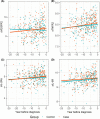Pre-diagnostic levels of sVEGFR2, sTNFR2, sIL-2Rα and sIL-6R are associated with glioma risk: A nested case-control study of repeated samples
- PMID: 35029050
- PMCID: PMC8855896
- DOI: 10.1002/cam4.4505
Pre-diagnostic levels of sVEGFR2, sTNFR2, sIL-2Rα and sIL-6R are associated with glioma risk: A nested case-control study of repeated samples
Abstract
No strong aetiological factors have been established for glioma aside from genetic mutations and variants, ionising radiation and an inverse relationship with asthmas and allergies. Our aim was to investigate the association between pre-diagnostic immune protein levels and glioma risk. We conducted a case-control study nested in the Northern Sweden Health and Disease Study cohort. We analysed 133 glioma cases and 133 control subjects matched by age, sex and date of blood donation. ELISA or Luminex bead-based multiplex assays were used to measure plasma levels of 19 proteins. Conditional logistic regression models were used to estimate the odds ratios and 95% CIs. To further model the protein trajectories over time, the linear mixed-effects models were conducted. We found that the levels of sVEGFR2, sTNFR2, sIL-2Rα and sIL-6R were associated with glioma risk. After adjusting for the time between blood sample collection and glioma diagnosis, the odds ratios were 1.72 (95% CI = 1.01-2.93), 1.48 (95% CI = 1.01-2.16) and 1.90 (95% CI = 1.14-3.17) for sTNFR2, sIL-2Rα and sIL-6R, respectively. The trajectory of sVEGFR2 concentrations over time was different between cases and controls (p-value = 0.031), increasing for cases (0.8% per year) and constant for controls. Our findings suggest these proteins play important roles in gliomagenesis.
Keywords: a nested case-control study; cytokines; glioma aetiology.
© 2022 The Authors. Cancer Medicine published by John Wiley & Sons Ltd.
Conflict of interest statement
The authors declare no conflict of interest.
Figures


References
-
- Iwami K, Natsume A, Wakabayashi T. Cytokine networks in glioma. Neurosurg Rev. 2011;34:253‐263; discussion 63‐4. - PubMed
Publication types
MeSH terms
LinkOut - more resources
Full Text Sources

